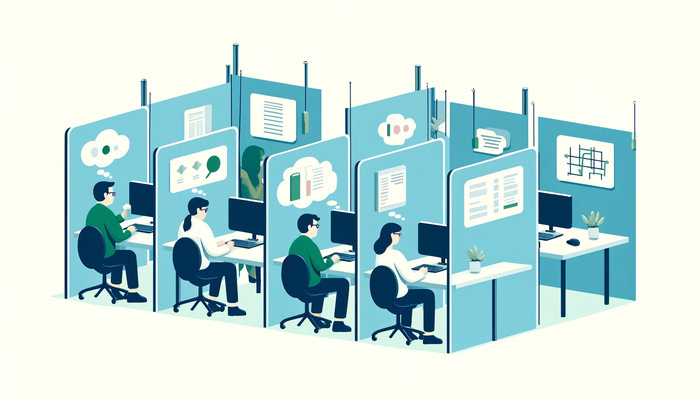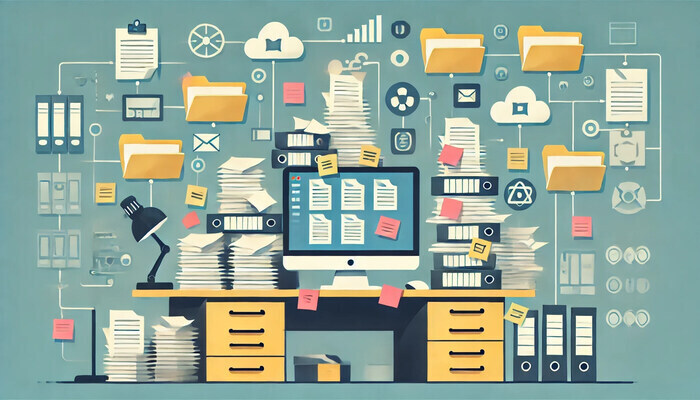
Imagine a mid-sized company, let’s call it “CodeCrafters,” that has not yet adopted a knowledge management portal. The technical writers at CodeCrafters face a challenging and inefficient work environment typical of the pre-digital era.
They rely on a disjointed system of document management, using a combination of local drives, shared folders, and email to create, store, and share documents. This results in multiple versions of the same document existing simultaneously. Additionally, collaboration at CodeCrafters is cumbersome and time-consuming. Writers often work in silos, unaware of their colleagues’ progress or challenges.
Searching for specific information is a nightmare. Writers waste hours sifting through folders and files trying to find a particular piece of documentation. Without search functionality, tagging, or indexing, retrieval becomes a time-intensive task.
In this blog, we will focus on how knowledge management portals can help technical writers create quality content, enjoy streamlined collaboration, and deliver up-to-date documentation, thereby enhancing both the employee and customer experience.
What Is a Knowledge Management Portal?
Knowledge Management (KM) focuses on the systematic management of an organization’s knowledge assets. It encompasses the processes of creating, sharing, using, and managing information and knowledge within an organization.
The cornerstone of KM is Knowledge Management Portal (KMP), a centralized platform designed to facilitate the collection, organization, and retrieval of knowledge. KMPs connect individuals with the resources they need to perform their roles effectively. They are not just repositories but dynamic ecosystems that adapt to the evolving needs of the organization, promoting a culture of continuous learning and knowledge sharing.
Key Features of a Knowledge Management Portal
A Knowledge Management Portal (KMP) is an essential tool for modern organizations, designed to streamline the flow of information and foster a collaborative work environment. Here is an overview of its key features:
- Centralized repository. At the core of a KMP is the centralized repository, which acts as a single source of truth for the organization. It consolidates all types of knowledge assets, from documents and multimedia to best practices and case studies, ensuring that information is easily accessible.
- Search functionality. A robust search engine enables users to quickly locate the information they need. Advanced search capabilities, including filtering and tagging, allow for precise retrieval of knowledge assets, saving time and reducing frustration.
- Content curation and collaboration. KMPs support content curation through tools that enable peer review, feedback, and collaborative editing, which are vital for maintaining the quality and relevance of information.
- Access controls and security. Security is paramount in a KMP. Access controls ensure that sensitive information is protected. This feature maintains the integrity of the knowledge base and complies with regulatory requirements.
- Integration capabilities. To maximize efficiency, KMPs often feature integration capabilities with other enterprise systems such as CRM, ERP, and project management tools. This interconnectedness allows for seamless knowledge transfer and application across various business functions.
These features collectively make a KMP not just a repository but a dynamic workspace that enhances knowledge accessibility, encourages collaborative growth, and supports informed decision-making.
Benefits of Implementing a Knowledge Management Portal
The adoption of a KMP within an organization serves as a catalyst for a host of improvements across the board, touching on everything from daily operations to overarching strategic goals.
When information is centralized through a KMP, employees find what they need with ease, cutting down on the hunt for data and speeding up task completion, which in turn elevates productivity.
Centralization also empowers decision-makers with a full spectrum of knowledge. With a comprehensive repository of information, decision-makers have access to all the knowledge they need to make informed decisions. This leads to better outcomes and a more strategic approach to business challenges.
Moreover, a KMP is not just a repository; it is a breeding ground for innovation and a hub for ongoing learning. It encourages the exchange of ideas and keeps the workforce abreast of the latest trends and practices. In the face of inevitable staff changes, it acts as a safeguard for an organization’s intellectual wealth, capturing the collective know-how of its people.
Communication and collaboration are also given a boost with a KMP. It provides the tools that foster dialogue and collective effort, leading to stronger team dynamics and a more unified workplace atmosphere.
All these advantages collectively shape an organization that is agile, well-informed, and ready to tackle new challenges and seize emerging opportunities.
How Tech Writers Can Benefit from KMPs?
Technical writers can reap significant benefits from knowledge management portals in several ways:
- Streamlined research. KMPs serve as a centralized database of information, reducing the time tech writers spend on research. They can quickly find necessary technical documentation and other resources, all in one place.
- Consistency. With access to existing materials and templates, tech writers can ensure consistency across various documents.
- Collaboration. KMPs often include features that allow multiple authors to work on a document simultaneously. This collaborative environment can improve the quality of the content and speed up the writing process.
- Knowledge sharing. Tech writers can use KMPs to share their expertise with colleagues, contributing to the collective knowledge base of the organization.
- Feedback. KMPs can facilitate peer reviews and feedback, providing tech writers with insights into how their work can be improved. This continuous feedback loop can lead to higher quality documentation over time.
- Professional development. By engaging with a KMP, tech writers are exposed to a wealth of knowledge that aids in their professional growth. They can stay updated with the latest industry trends, tools, and best practices.
KMPs can transform the way tech writers operate, making them more efficient, consistent, and collaborative, while also fostering an environment of continuous learning and improvement.

Steps to Create an Effective Knowledge Management Portal
Creating an effective KMP involves a series of strategic steps to ensure the portal meets the specific needs of an organization and is embraced by its users. Here is a detailed overview of each step:
Assessing Organizational Needs
This initial phase involves understanding the unique requirements of the company. It includes identifying the types of knowledge that need to be managed, the stakeholders who will use the KMP, and the goals the organization aims to achieve. Input from various departments is essential to ensure a comprehensive understanding of the organization’s needs.
Designing the User Experience
The success of a KMP relies heavily on its user-friendliness and intuitiveness. Designing the user experience requires a focus on the interface and navigation, ensuring users can find what they need without frustration. This might involve creating personas and user journey maps to visualize how different users will interact with the portal.
Selecting the Right Platform
The platform chosen should be robust enough to handle the organization’s data and flexible enough to accommodate future needs. Factors to consider include scalability, security, compatibility with existing systems, and support for various content formats.
Implementing Best Practices for Content Management
Content management is crucial for the effectiveness of any KMP. Implementing best practices involves establishing clear guidelines for content creation, categorization, tagging, and archiving. This ensures that the content remains relevant, up-to-date, and easily retrievable.
Encouraging Adoption and Participation
The final step is to drive adoption and encourage active participation among users. This can be achieved through training sessions, incentives, and regular communication about the benefits and new features of the KMP. Soliciting user feedback and using it to make continuous improvements is also essential.
By following these steps, an organization can create a KMP that not only serves as a repository of knowledge but also as a dynamic tool that enhances collaboration, innovation, and decision-making across the enterprise.
ClickHelp as a Knowledge Management Portal
ClickHelp is a cloud-based documentation platform that can effectively serve as a knowledge management portal (KMP). It offers a range of features that make it suitable for creating, managing, and sharing knowledge within an organization. Here is how ClickHelp can function as a KMP:
- Centralized documentation. ClickHelp allows organizations to centralize their technical documentation, user manuals, FAQs, and more in a single, searchable portal.
- Collaboration features. It supports real-time collaboration among team members, essential for maintaining up-to-date and accurate content.
- Access control. ClickHelp provides fine-grained permissions, enabling control over who can view or edit specific content pieces, ensuring security and confidentiality.
- Multi-format support. The platform accommodates various content formats, including text, images, and videos, making it versatile for different types of knowledge sharing.
- SEO features. ClickHelp includes SEO tools to enhance content visibility, facilitating easier information retrieval via search engines.
- Analytics. Built-in analytics track how content is used, providing insights to improve the KMP effectively.
- User feedback. Users can leave comments and ratings on documentation, offering valuable feedback to content creators.
- Customization. ClickHelp allows customization of the portal to align with the company’s branding, ensuring a seamless user experience.
Overall, ClickHelp can be a powerful solution for organizations seeking a user-friendly, collaborative, and adaptable KMP to meet their knowledge management needs.

Conclusion
Knowledge management portals stand as pivotal tools for leveraging the collective knowledge base of organizations. They transform information silos into dynamic ecosystems that foster collaboration, innovation, and strategic decision-making. By centralizing knowledge, facilitating seamless collaboration, and encouraging active participation, KMPs empower individuals to contribute to and benefit from the shared intelligence of their organization.
The implementation of robust KMPs, such as ClickHelp is not just a strategic asset but a necessary evolution for organizations aiming to thrive in an information-driven world. The power of KMPs lies in unlocking the full potential of a company’s most valuable asset — its knowledge — turning individual insights into a collective force that drives success and competitive advantage.
Good luck with your technical writing!
ClickHelp Team
Author, host, and deliver documentation across platforms and devices.



